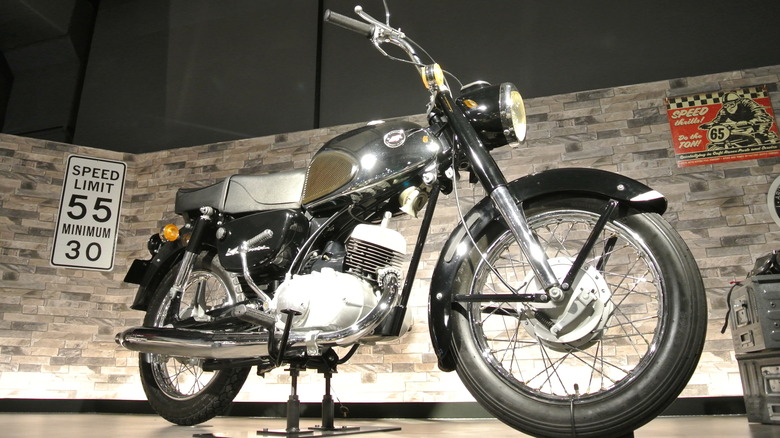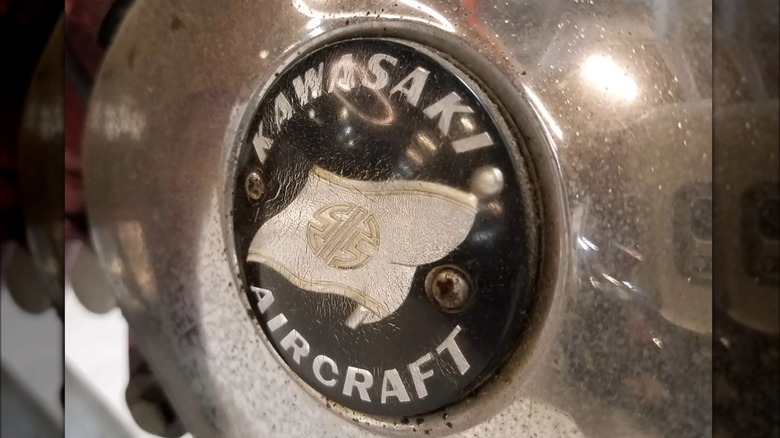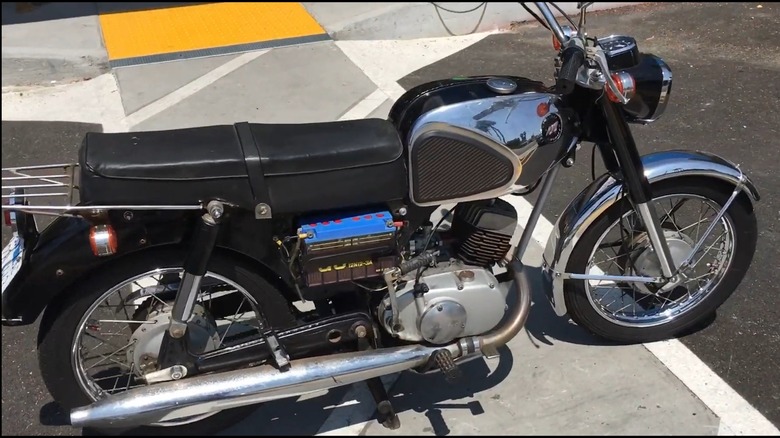How Airplane Engine Tech Created Kawasaki's Oldest Motorcycle (60 Years Ago)
When you think of Kawasaki, you likely think of one of the brand's iconic bikes, like the ever-famous Kawasaki Ninja motorcycle. However, while the Japanese manufacturer is well-known for its bikes, the company has a lengthy history of creating ships, submarines, trains, and aircraft. Forty years after founder Shozo Kawasaki put together the company's first enterprise, the Kawasaki Tsukiji Shipyard, the aviation department was created in 1918.
Before Kawasaki's first motorcycle was developed, its aviation engineers were hard at work making cutting-edge aircraft, like World War II's Ki-61 or the experimental Japanese aircraft, the Kawasaki Ki-78. Once Kawasaki decided to give motorcycle manufacturing a go in the early 1960s, the lessons the company learned in aviation design — like perfecting air-cooling technology and how to build vehicles that were lightweight but sturdy — would come in handy. When the manufacturer's first bikes rolled out of the Kawasaki Aircraft plant, they were purely a local phenomenon. But soon, the company would experience explosive international growth.
[Featured image by Rainmaker47 via Wikimedia Commons | Cropped and scaled | CC BY-SA 4.0]
Kawasaki used the air-cooling engine from its aircraft
Many classic aircraft were air-cooled as airflow is naturally abundant while flying in the sky. However, just exposing the engine to outside air wasn't the most efficient way of capturing and funneling its cooling potential to specific areas. That's why engineers outfit aircraft with metal fins to direct and focus air to increasingly hot engine locations.
In 1949, Kawasaki engineers got to work creating the engine for the brand's first motorcycle, the B8. This engine also utilized air-cooling technology, but some adjustments needed to happen before adapting this type of engine to a two-wheeled ground vehicle. For aircraft, which can travel at hundreds of miles per hour, engineers could place more fins on the engine and locate them closer together to increase cooling. The force of air was great enough at high speeds to force air through the narrow fins, cooling the engine.
However, Kawasaki's air-cooled motorcycle couldn't manage such speeds. Instead, for such a vehicle, it was necessary for the gap between fins to be at least a quarter of an inch apart to absorb heat and direct airflow effectively. In addition, since motorcycles may only use high levels of throttle for brief periods (unlike an aircraft), it's necessary for quite a bit of metal to be incorporated in the engine for greater heat absorption.
Like aircraft, Kawasaki motorcycles had to balance strength and weight
Another lesson from aviation that helped engineers produce the Kawasaki B8 was the relationship between weight, strength, and performance. Aircraft engineers must adhere to the aircraft design principle that planes have to be light enough to stay sustained in the air but sturdy enough that if they crash there is actually some chance for survival. If you create an aircraft with more durable materials, the craft's fuselage will be more sturdy but also considerably more weighty. Of course, it's equally problematic if you construct an aircraft with exceptionally lightweight components that can't stand up to the rigors of flying.
Finding a balance between a durable design and lightweight construction translates from aircraft into motorcycle manufacturing. The Kawasaki B8, first produced in 1962, has a dry weight of 256 pounds. The bike's light 125cc two-stroke engine was robust enough to win the top six places in the 1963 Aonogahara motocross event in Japan while still being able to handle the rigors of the course. It's good fortune for bike enthusiasts today that engineers could strike this balance and bring the majorly successful B8 to fruition. Otherwise, the fastest motorcycles Kawasaki ever built wouldn't exist.


